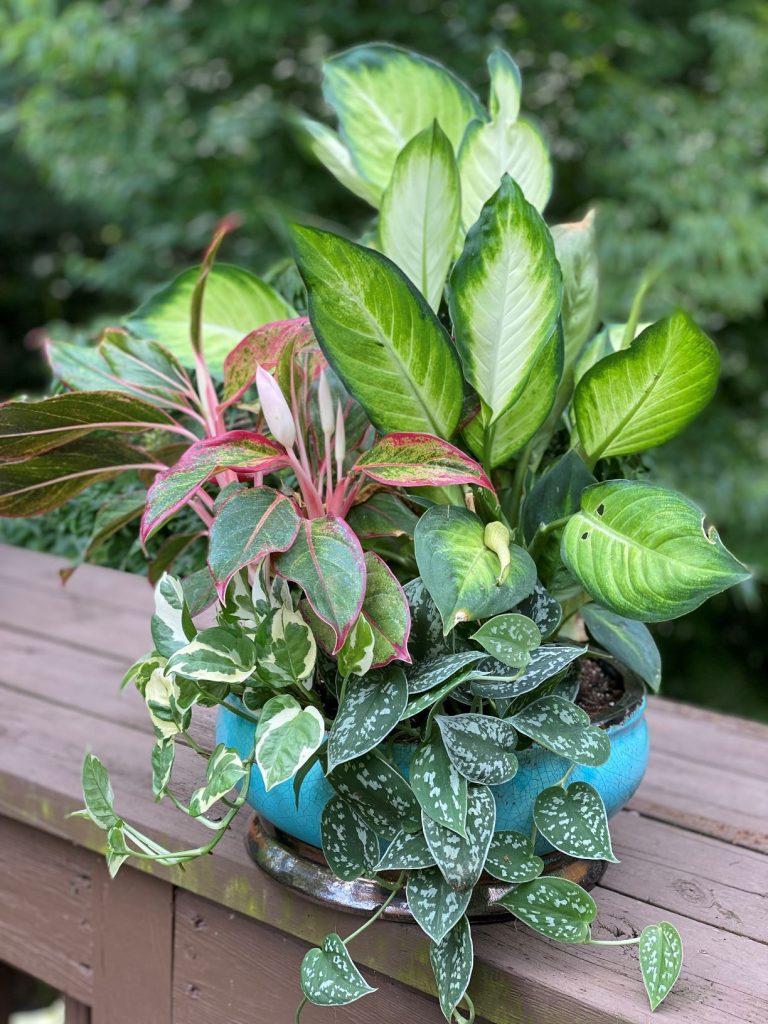House plants bring life, vitality and calm to your home. But there's no rule that says you can't grow your favorite houseplants outdoors during the warmer months. I love the lush tropical feel that houseplants bring to my Virginia patio and garden in the summer. Their versatility and resilience inspired me to write a book, Tropical Plants and How to Love Them, to help others do the same with their favorite houseplants. Here are 4 easy ways to use houseplants to decorate your garden or outdoor planter. Plus, we'll share tips on how to successfully grow your houseplants outdoors and bring them back indoors.
Marianne Wilburn
1. Anchor your seating area with a large potted plant
Do you have a hard-working schefflera or ficus in a corner? These plants, as well as larger architectural indoor plants like strelitzia, monstera, dracaena and many palms, are equally impressive on decks, balconies and patios. These plants blend naturally into seating and dining areas, creating a sense of enclosed space and privacy. For extra ambiance, I like to drape copper wire LED string lights on a timer across the branches of indoor trees and larger houseplants.
Marianne Wilburn
2. Add some fun to your garden beds
Houseplants are an easy way to take a run-of-the-mill flower bed to the next level. For example, in my fern-filled shade garden, I add an unexpected element with some hardy, prickly plants like sansevieria, bromeliads, and dracaena. You can plant your houseplants directly in the ground until the end of the season (once the soil has warmed up), but you can save a little work and stress on your plants by not planting them. Instead, repot your houseplants each year at the start of the season, then sink the pots into the garden where you want to use them.
If plants in a neighbor's yard obscure the border, you can simply bury the pot in a shallow hole instead of burying it completely. Don't forget to water the houseplant along with your other potted plants during the season. When it's time to bring the houseplant back indoors, lift the pot out of the ground. Clean the outside of the pot and cut off any overhanging roots before bringing the plant back inside.
Marianne Wilburn
3. Show off colorful foliage with creative combinations
Houseplants with beautiful leaf patterns or colors can be fun to mix and match in pots. I especially like to group small plants with similar growing conditions together in one outdoor pot, so they don't dry out as much. For example, this wide, shallow pot contains a dieffenbachia, a pothos, a climbing philodendron, and a bright pink aglaonema.
To create your own mix, choose houseplants that have similar watering and light needs, and follow the classic container gardening mantra “thriller, filler, spiller” to create an arrangement that's much more than the sum of its parts: use one tall focal plant, one or two shorter plants to fill in around it, and a few plants that hang down from the sides.
Ceramic glazed pots or self-watering plastic containers are perfect for collections like this, helping to retain moisture and adding a pop of color to your favorite houseplants. You might even love this combination so much that you'll bring your container gardens indoors to brighten up those winter days.
Marianne Wilburn
4. Create a strong focal point in your container
Container gardens look more dynamic when planted around taller, upright plants (like your climbing plants). If the usual vertical accents available at your local garden center don't appeal to you, why not try your favorite medium-sized houseplants? My favorite choices are bromeliaceae, sansevierias, and dracaenas, which offer unique structure and blend well with more common container garden plants like verbena, calibrachoa, impatiens, and sedges. Plus, these plants can withstand end-of-season repotting and tolerate direct sunlight.
Tips for moving indoor plants outdoors
Most houseplants thrive in bright light and a well-ventilated environment during their outdoor growing season, and with regular watering and occasional fertilization, your plants will come back indoors looking fresh and lush in the fall. However, it's best to gradually transition your indoor plants to an outdoor environment. Start moving your houseplants outdoors once nighttime temperatures are reliably above 50°F. Use a shady space as a storage location until your houseplants have adapted to the higher light levels. Adjust your fertilizer and watering habits as you would any other potted plant you grow outdoors.
Place them in outdoor garden beds, accent baskets, or place freestanding plants in containers to add privacy to your deck or patio. Then, before temperatures drop significantly in the fall, check your plants carefully for pests and remove them if necessary, then bring them back inside to brighten up your interior spaces and winter moods.

